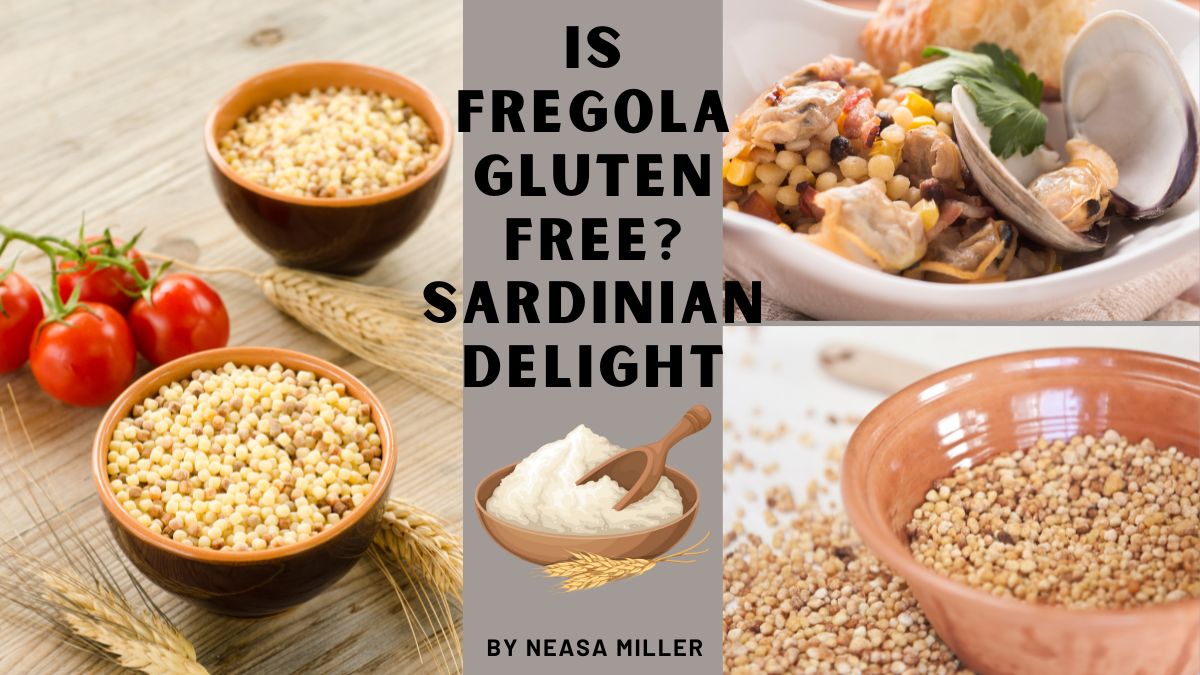Whether it’s because of celiac disease, non-celiac gluten sensitivity, or the desire for a healthy lifestyle, gluten-free diets have surged in popularity in recent years. Different grains and products have come under examination as people look for alternatives to typical wheat-based diets. Fregola, a distinctive Sardinian pasta that resembles tiny, toasted balls of couscous, is one example of this. By looking into the materials, manufacturing process, and potential gluten level of fregola, this article seeks to answer your question in great detail.
What Exactly Is Fregola?
Fregola, also known as fregula, originates from Sardinia, a beautiful island tucked away in the middle of the Mediterranean Sea. It is hand-rolled, perfectly toasted, and prepared from semolina wheat flour and water. This produces a little, spherical pasta that is satisfyingly chewy and has a wonderful, mildly nutty flavor. Fregola is highly adaptable and may be used in a wide range of dishes, including seafood and meat-based dishes as well as soups and salads.
Learning About Gluten
Understanding what gluten is and why it matters, especially to people with certain dietary requirements, is crucial before digging into the gluten level of fregola.
Wheat, barley, rye, and products made from these grains all include the protein gluten. It gives dough flexibility, which enhances the baked items’ structure and texture. Gluten can, however, have negative effects for people who have celiac disease, non-celiac gluten sensitivity, or wheat allergy, ranging from digestive problems to serious health difficulties.
Ingredients of Fregola
Fregola, a typical Sardinian pasta, is renowned for having a distinct flavor and texture. The following are some of the relatively straightforward ingredients that go into preparing fregola:
Wheat Semolina Flour: The main component of traditional fregola is wheat semolina flour. Due to the high gluten concentration of durum wheat, semolina is a coarsely crushed form of flour. To make the dough for fregola, this wheat flour is combined with water.
Water: To make the dough, water is added to semolina wheat flour. The right amount of water is necessary to get the proper consistency and texture of fregola.
A dash of salt is sometimes used in fregola recipes to bring out the flavor of the pasta. The quantity of salt used can change depending on taste preferences and regional differences.
Is Fregola’s Gluten Free?
Since semolina wheat is used to make fregola, it naturally includes gluten. Therefore, eating traditional fregola is unsafe if you have celiac disease, gluten sensitivity, or wheat allergies.
It’s crucial to remember that various fregola versions have appeared in response to the rising demand for gluten-free substitutes. These variations are made with substitute flour like rice flour, maize flour, or even gluten-free flour like almond or chickpea flour. These substitutes are ideal for those with dietary restrictions because they are intended to be gluten-free.
But it’s important to carefully check the product labels before buying a fregola. Manufacturers may opt to utilize gluten-free flour or wheat-based semolina, and the packaging should clearly state which kind of flour was used in the manufacturing process.
Concerns About Cross-Contamination
There is a chance of cross-contamination during the production process even if a fregola product is prepared with gluten-free flour. When gluten-free and gluten-containing products are manufactured in the same locations or on the same machinery, cross-contamination happens.
Look for fregola items that have been certified gluten-free to reduce this danger. To ensure that they adhere to the requirements for being gluten-free stipulated by the relevant authorities, these goods go through stringent testing and quality control. For those who must rigorously avoid gluten, certification adds another level of assurance.
Safe Fregola Cooking
To ensure safety when preparing fregola at home while adhering to a gluten-free diet, remember the following:
1. Read all labels Always look at the package to see whether there are any obvious signs that the product contains wheat-based semolina or is gluten-free.
2. Separate Cooking Utensils: To avoid cross-contamination, cook gluten-free fregola in separate pots, pans, and utensils.
3. Boiling Water: Ensure that the water used to prepare the fregola is pure and gluten-free.
4. Frequent stirring is necessary to keep the fregola from sticking together and to provide an even texture.
5. Serve Safely: To prevent cross-contamination on the dining table, use a separate, clean bowl and utensils for serving.
Fregola Alternatives Without Gluten
Try other types of gluten-free pasta if you have dietary limitations and are looking for a substitute for conventional fregola. Popular varieties of gluten-free pasta include:
1. Rice pasta, made from rice flour, is a versatile gluten-free choice with a neutral flavor.
2. Corn Pasta: For people who are sensitive to gluten, corn pasta is a great substitute because of its somewhat sweet flavor.
3. quinoa Quinoa Pasta: It is a nutrient-rich option for a gluten-free diet because it is produced from quinoa flour and is strong in protein.
4. Pasta with lentils: Lentil pasta is not only gluten-free but also high in protein and fiber because it is made from lentil flour.
5. Chickpeas Pasta: Chickpea pasta is a satiating gluten-free option since it has a distinct flavor and a high amount of protein.
Summary
Here is a list of essential details to help you quickly determine whether Fregola is gluten-free:
1. Traditional Fregola Contains Gluten: Since semolina wheat flour, which is used to make traditional fregola, contains gluten, traditional fregola is not gluten-free.
2. Variations without gluten Exist: For individuals who must avoid gluten, there are gluten-free varieties of fregola made from different flours like rice or maize.
3. Optional certified gluten-free products include several fregola brands that adhere to stringent safety requirements in the event of celiac illness or gluten sensitivity.
4. Use separate pots and utensils to prevent cross-contamination and make sure the water is gluten-free while preparing gluten-free fregola.
5. Alternatives to Gluten-Free Pasta: There are several gluten-free pasta options you can choose from, including rice pasta, maize pasta, quinoa pasta, lentil spaghetti, and chickpea pasta.
6. Carefully examine product labels to discover whether they are gluten-free or prepared using gluten-free flour before purchasing anything.
7. Risks of cross-contamination may exist in conventional fregola-producing plants. To reduce this danger, choose a fregola that has been certified gluten-free.
8. Traditional and gluten-free varieties of fregola contain semolina wheat, however, gluten-free variants use other flours, which is the primary difference between them.
9. savory Gluten-Free Options: When made with delectable ingredients and seasonings, gluten-free fregola may be just as savory as regular fregola.
Final Thoughts
Traditional fregola is not gluten-free since it is prepared with semolina wheat flour. For people with dietary problems, fregola is also available in gluten-free varieties. Always carefully check the labels while choosing fregola, and when necessary, select items that are Gluten-Free certified. Follow proper cooking procedures as well to avoid cross-contamination.
Investigating gluten-free pasta options is a delightful and secure way for people with celiac disease, non-celiac gluten sensitivity, or wheat allergies to enjoy pasta recipes without worrying about gluten-related health issues. With more and more gluten-free items becoming available, you may enjoy fregola’s tastes while following your dietary restrictions.
Related Posts

I’m Neasa Miller, a professional dietitian with 5 years of experience. I founded glutenfreelifestyles.org to assist people online in embracing gluten-free living. Read more about me
